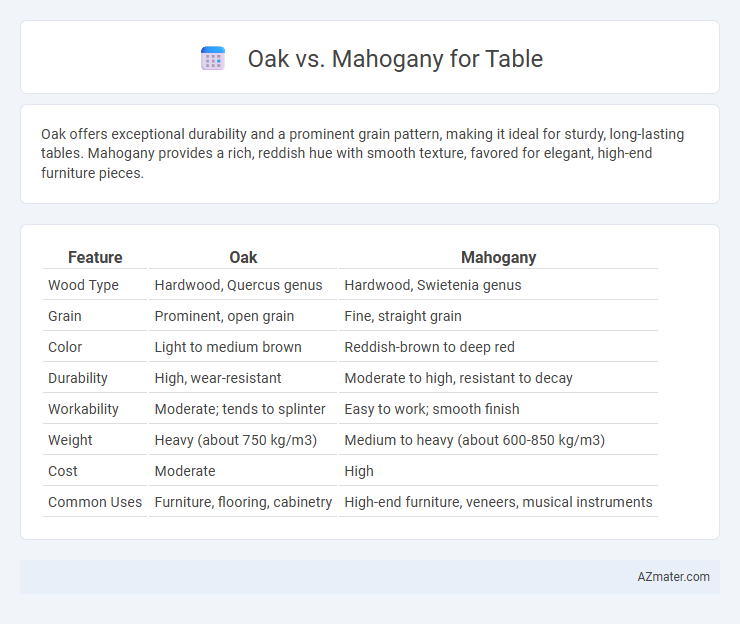Oak offers exceptional durability and a prominent grain pattern, making it ideal for sturdy, long-lasting tables. Mahogany provides a rich, reddish hue with smooth texture, favored for elegant, high-end furniture pieces.
Table of Comparison
| Feature | Oak | Mahogany |
|---|---|---|
| Wood Type | Hardwood, Quercus genus | Hardwood, Swietenia genus |
| Grain | Prominent, open grain | Fine, straight grain |
| Color | Light to medium brown | Reddish-brown to deep red |
| Durability | High, wear-resistant | Moderate to high, resistant to decay |
| Workability | Moderate; tends to splinter | Easy to work; smooth finish |
| Weight | Heavy (about 750 kg/m3) | Medium to heavy (about 600-850 kg/m3) |
| Cost | Moderate | High |
| Common Uses | Furniture, flooring, cabinetry | High-end furniture, veneers, musical instruments |
Introduction: Oak vs Mahogany for Tables
Oak offers exceptional durability and a prominent grain pattern, making it ideal for sturdy, long-lasting tables, while mahogany provides a rich, deep reddish-brown hue with a smooth, fine grain that enhances elegance and warmth. The density of oak contributes to its resistance to dents and wear, whereas mahogany's worked softness allows for intricate detailing and a luxurious finish. Choosing between oak and mahogany hinges on balancing robust functionality with refined aesthetics for table craftsmanship.
Appearance and Grain Patterns
Oak presents a prominent, coarse grain pattern with distinctive rays and knots that add character and a rustic appeal to tables. Mahogany features a smoother, more uniform grain with rich, deep reddish-brown hues that create an elegant, luxurious look. The contrast between oak's bold texture and mahogany's refined appearance influences the overall aesthetic, making oak ideal for traditional or country styles, while mahogany suits classic and formal settings.
Color Variations and Aesthetics
Oak tables showcase a range of color variations from light golden hues to medium brown tones with distinct grain patterns that enhance rustic and traditional aesthetics. Mahogany offers deeper, richer reddish-brown shades that darken over time, lending a luxurious, elegant appearance ideal for formal and classic interiors. Both woods provide durable finishes, but oak's natural texture emphasizes warmth and versatility while mahogany's smooth grain creates a refined, polished look.
Durability and Hardness
Oak is renowned for its exceptional durability and hardness, with a Janka hardness rating of approximately 1,290, making it highly resistant to dents and scratches for long-lasting table surfaces. Mahogany, with a Janka hardness rating around 900, offers moderate durability but excels in stability and resistance to warping, often favored for its rich color and smooth finish. Tables crafted from oak withstand heavy use and impact better, whereas mahogany tables provide a balance of aesthetic appeal and sufficient hardness for everyday functionality.
Workability and Crafting
Oak offers excellent workability for table crafting due to its open grain and hardness, allowing for detailed shaping and durability in furniture design. Mahogany's fine, straight grain provides smooth sanding and carving, making it a preferred choice for intricate joinery and high-quality finishes. Both woods balance strength and aesthetic appeal, but Mahogany tends to be easier to work with hand tools, while Oak withstands heavy use in functional tables.
Cost Comparison
Oak tables generally offer a more budget-friendly option, with prices ranging from $200 to $900 depending on quality and craftsmanship, making them suitable for cost-conscious buyers. Mahogany tables, known for their rich color and durability, typically start around $700 and can exceed $2,500, reflecting the wood's premium status and slower growth rate. Choosing oak provides a balance of durability and affordability, while mahogany commands a higher investment for its luxury appeal and long-term value.
Maintenance and Longevity
Oak tables require regular polishing and occasional resealing to maintain their durability, benefiting from their natural resistance to scratches and dents. Mahogany demands less frequent refinishing due to its dense grain but is more susceptible to moisture damage, necessitating careful protection from spills. Both woods offer exceptional longevity when properly maintained, with oak providing a slightly tougher, more wear-resistant surface ideal for high-traffic areas.
Environmental Impact and Sustainability
Oak is recognized for its fast growth rate and ability to thrive in diverse climates, making it a more sustainable choice compared to mahogany, which grows slower and is often sourced from endangered tropical forests. Mahogany harvesting has been linked to deforestation and habitat loss, contributing to significant environmental concerns. Choosing certified sustainable oak supports forest regeneration and reduces the carbon footprint of your furniture.
Best Uses for Oak and Mahogany Tables
Oak tables are ideal for high-traffic areas such as dining rooms and kitchens due to their exceptional durability and resistance to wear, making them perfect for family gatherings and daily use. Mahogany tables excel in formal settings like offices or living rooms, where their rich, deep color and fine grain add an element of luxury and elegance. Both hardwoods offer longevity, but oak's sturdiness suits casual, heavy-use environments, while mahogany's aesthetic appeal enhances sophisticated, low-traffic spaces.
Conclusion: Choosing the Right Wood for Your Table
Oak offers exceptional durability and a prominent grain pattern that suits rustic and traditional table designs, while mahogany provides a rich, deep color and smooth texture, ideal for a more elegant and formal appearance. Consider oak for high-traffic areas where resistance to wear and scratches is essential, and opt for mahogany when prioritizing aesthetic warmth and fine craftsmanship. Selecting the right wood hinges on balancing the table's function, style preference, and budget to ensure long-lasting satisfaction.

Infographic: Oak vs Mahogany for Table
 azmater.com
azmater.com